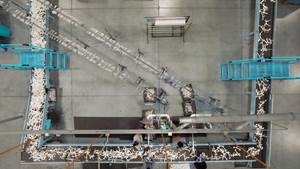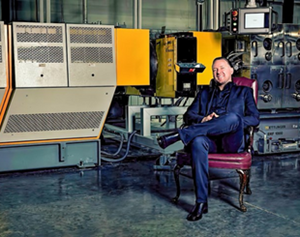Dedusting Turns Risky Regrind Into a Valuable Resource
Custom injection molder Tessy Plastics, Elbridge, N.Y., used to spend around $117,000 every year on resins that it would not use.
Custom injection molder Tessy Plastics, Elbridge, N.Y., used to spend around $117,000 every year on resins that it would not use. That amount was how much the molder figured was lost by generating just 1% scrap from processing 180,000 lb of resins a week, averaging $1.25/lb.
It wasn’t that the company didn’t want to reuse that scrap. “We know that if conditions are right, molders can significantly increase profit margins by increasing the amount of regrind used in the production process,” says Allan Sheriff, inventory control supervisor at Tessy. What kept this molder from using most of its regrind was the very real possibility that it would cause even more wasted material.
Regrind can be risky
Tessy has 131 injection presses in two buildings at Elbridge. (It also has smaller facilities in Lynchburg, Va., and Shanghai, China.) The firm runs a variety of thermoplastics but uses mostly polycarbonate. It makes 130 or so job changeovers at Elbridge every week, which generates scrap while molds are being started up and conditions optimized, says Sheriff.
The company has shredders and granulators to regrind runners and parts, but until relatively recently, Tessy rarely ran regrind. “It just wasn’t worth the effort because regrind has a downside—dust,” warns Sheriff. “In many instances the dust content in the regrind reaches more than 10%. Even in virgin pellets, dust content of 1% by weight is considered significant,” says Sheriff. Use of dusty regrind often resulted in a myriad of part or process problems. “The dust would cause problems in the molding machine, such as affecting the cushion of the injection cycle. This could lead to material degradation. Some material would actually burn. The dust in the regrind could cause cosmetic problems such as specks and swirls and discoloration. If we were fortunate we could sell the dust to a recycler, but if we found no market for it we would just throw it away,” says Sheriff.
Tessy didn’t think upgrading its size reduction technology was an answer, since it was not clear that a new shredder or granulator would do a better job in reducing the dust.
Getting the dust out
During a $7.6-million expansion, the company invested in material dedusting technology, purchasing a unit from Pelletron Corp., Lancaster, Pa. The deduster, installed apart from the presses and near the regrind room, uses a flux-field generator to disrupt the static charge between the regrind and the dust particles. The system uses air to lift the dust away from the resin, and then a vacuum system removes the dust, leaving the cleaned regrind to fall into a bottom storage bin for reuse.
Tessy is now able to mold parts to specification while including some regrind material in the part to help reduce cost. “Currently 50 of our jobs use reground and dedusted material where previously it was zero. A job may now contain anywhere from 10% to 35% regrind,” says Sheriff. For one customer Tessy was able to produce two orders of product using 100% regrind. “That cut our customer’s costs by more than 50%,” Sheriff adds. Tessy even uses the deduster on its virgin resins to minimize the chance of quality problems.
Without the dedusting Tessy says its production efficiency was about 80% over 24 hr, but with the deduster it is easily between 90% and 100% efficient.
Tessy says the dedusters require little maintenance, just filter replacement two or three times a year. The firm now has two Pelletron P10 mid-range Dedusters (1000 lb/hr) and is looking to purchase a P1 mini DeDuster that mounts atop the hopper for dedusting at the machine.
Related Content
Recycling: What's Ahead in Advanced Sorting Technology
As the industry tries to ramp up recycling, there are several innovative sorting solutions in the offing—ranging from enhanced optical sorting technologies and chemical tracers to advanced solutions based digital watermarks and artificial intelligence.
Read MoreReversing Logistics for Plastic Film Recycling
Learn how Mainetti built a circular supply chain for clear film packaging.
Read MoreA Recycling Plant, Renewed
Reinvention is essential at Capital Polymers, a toll recycler that has completely transformed its operation in a short period of time.
Read MoreCompatibilizers Aid Recycling & Upcycling of Mixed Resins
Compatibilizers are proving their worth in boosting critical properties such as impact/stiffness balance of PCR and PIR blends of polyolefins and other plastics.
Read MoreRead Next
Processor Turns to AI to Help Keep Machines Humming
At captive processor McConkey, a new generation of artificial intelligence models, highlighted by ChatGPT, is helping it wade through the shortage of skilled labor and keep its production lines churning out good parts.
Read MoreUnderstanding Melting in Single-Screw Extruders
You can better visualize the melting process by “flipping” the observation point so that the barrel appears to be turning clockwise around a stationary screw.
Read MoreWhy (and What) You Need to Dry
Other than polyolefins, almost every other polymer exhibits some level of polarity and therefore can absorb a certain amount of moisture from the atmosphere. Here’s a look at some of these materials, and what needs to be done to dry them.
Read More

























